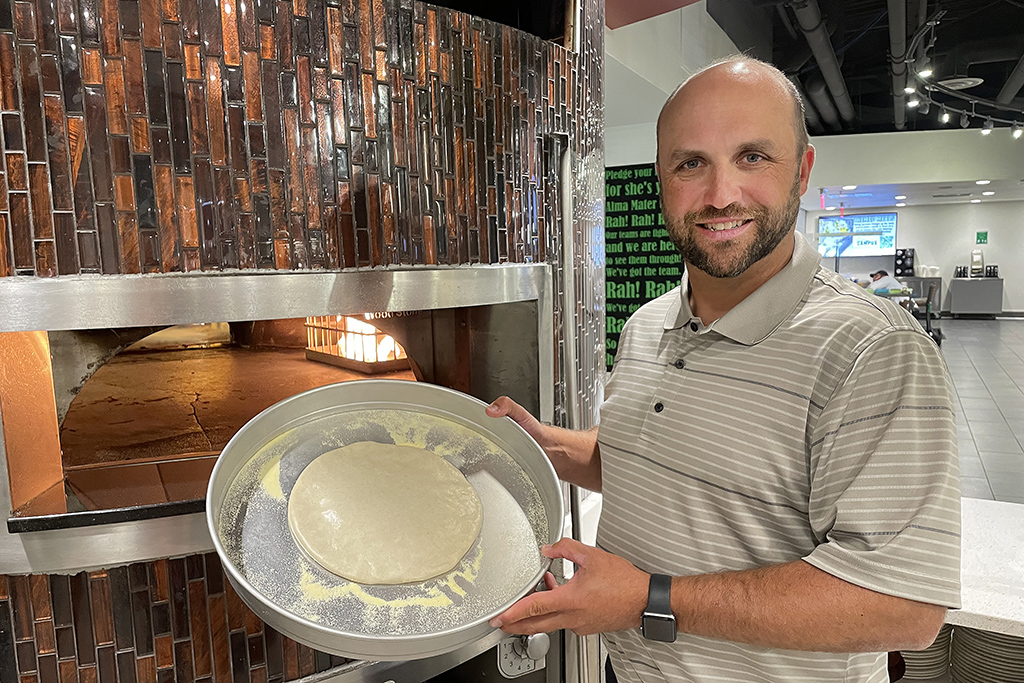Now they’re cooking
UND Dining Services mixes it up with local foods and more plant-based options on the menu

Jeff St. Michel settles into the booth and slides a small paper cup across the table as he hands the guest a plastic spoon.
“Do you want to have a taste? Tell us what you think,” says UND Dining Services’ longtime associate director of culinary support. “This is our first go at an all plant-based cheese sauce. It’s free of all the common allergens — no soy, no dairy, no eggs. It’s good, right?”
First a swirl, then a scoop.
Mm-hmm … the smooth and creamy sauce is rich and delicious.
It’s just the kind of home-cooked goodness one would expect for Sunday dinner at Grandma’s house — and soon it will come to a dining hall near you, not just on Sunday, but every day.
Finally, no worries. You can take that extra bite of hearty, rib-sticking macaroni and cheese with no regret. St. Michel and UND Registered Dietician Dustin Frize say the perennial favorite of college students is about to get even healthier.
And that’s some heavy intel. As the No. 1, most-popular dish, 1,120 pounds of mac-n-cheese is served every month at UND. (Just in case you’re curious, boneless chicken wings, burgers, street taco chicken carnitas and Asian pot stickers round out the rest of the Top 5 favorites.)
From farm to table
Always on the lookout for ways to heighten the health factor as well as shrink the carbon footprint and distance from farm to table, Frize says UND already made the switch in 2020 to a whole wheat pasta that’s made with a specialty wheat grown by farmers right here in the Red River Valley.
The Four Families company, headquartered in Casselton, N.D., boasts that its HealthSense High Fiber Wheat Flour and pasta deliver up to 10 times the dietary fiber of traditional wheat flour. Plus, they’re higher in protein and lower in calories than the white varieties. The North Dakota brands are sold in area grocery stores, and an added bonus is that a portion of sales goes to support Journey Home Animal Rescue in Grand Forks.
Now, you ask, what possibly could be better than happy pets and healthier noodles? Well, St. Michel says it just might be that new plant-based cooking cream they’re using to perfect the mac-n-cheese.
The maker of the culinary cream, Rich Products Corp. — also known as Rich’s — recently flew its company chef all the way from Texas to show St. Michel and other area restaurant chefs how to create about 25 new dishes to satisfy the ever-evolving palates of health-conscious diners.
Never mind that it tastes great, St. Michel says that because the plant-based cream is both vegan and gluten-free, it opens a whole new world of cuisine for people living with dietary restrictions.
“Students want to eat mainstream,” he explained. “They want to be part of the regular crowd and environment and not feel like they’re outcasts just because they can’t eat regular macaroni and cheese.”
Stirring the sample cup of cheese sauce once again, he comments how it holds together and isn’t granular like other nondairy cheeses can be. A few more tweaks, and chefs will be able to throw in a few different ingredients to create some brand-new flavor profiles — say, a creamy alfredo sauce or a spicy southwest variety for quesadillas. That’s yummy news for everyone.

Good for you and for all
Frize estimates that about 10 percent of students with UND meal plans face some kind of dietary restriction, whether that’s gluten sensitivity or allergies to one or more of what the FDA identifies as the eight most common food allergens: milk, eggs, fish, shellfish, peanuts, tree nuts, wheat and soybeans.
So many dietary variables can make it challenging to provide meals that are safe and satisfying for all. And that’s why food scientists are generating more and more healthy alternatives.
It’s not about figuring out what’s second-best. It’s more about finding that magical first in flavor.
A case in point: For 75 years, the Rich’s food giant made its bread and butter in baked goods, desserts, drinks and decorative toppings. Now, it’s introducing chefs to an entirely new level of savory possibilities with its plant-based culinary creams, nondairy cheeses and other plant-based products.
“They’ve been a leader in all the plant-based technology,” St. Michel said. “They’re really big into their cauliflower and zucchini pizza crusts.”
Added Frize: “Typically, you wouldn’t think of a slice of pizza as giving you a good source of daily fiber, but ours does, and that’s because we use this whole wheat flour. We use it in our muffins and our quick breads, too.
“It goes a long way to help reduce the fiber gap we tend to see with most Americans not getting enough of it in their diets. We can provide that head start for our students by producing a very high-quality, desirable dish like mac-n-cheese or pizza.”
And companies such as Rich’s have done the research to back up claims that there’s a growing appetite for more plant-based foods as part of more diverse, mainstream diets. In fact, 80 percent of the people surveyed said they either already regularly buy plant-based foods or are interested in doing so — with a heavy representation among women and younger populations.
Further, the company says 30 percent of millennials and 60 percent of Generation Z are trying to eat more plant-based foods. With that kind of demand fueling new food trends and technology, the experts say it’s more possible than ever to have your cake and eat it, too.
“This year, we used the culinary cream to create a new French toast batter that’s a game changer,” St. Michel said. “A student actually can get a piece of gluten-free bread that’s still soft and just as good. And it’s going to taste like French toast. Five years ago, there was no way you could get that. It was just garbage.”
Keeping it local
Besides the vegan cooking cream, the HealthSense Flour and Four Families pasta, St. Michel and Frize say they work hard to seek out good-quality local and regional brands. UND works with no fewer than 20 producers and suppliers based in North Dakota and Minnesota. Among them are the North Dakota Mill in Grand Forks, 8th Avenue Pasta (formerly known as Dakota Growers Pasta Co.) in Carrington, N.D., and Baker Boy in Dickinson, N.D. Others include North Dakota’s Cloverdale Meats in Mandan and Land O’ Lakes in Bismarck, as well as In Harvest in Bemidji, Minn., and Hormel Foods in Austin, Minn. Then, of course, there’s American Crystal Sugar Co. with factories in several nearby towns.
St. Michel recalled a state initiative that came out of the North Dakota governor’s office some years back.
“They wanted us to use as many North Dakota-produced and state-supportive products as we could,” he said. “Even though it’s no longer an official initiative, we’ve never really gotten away from that. We really want to support our local and regional manufacturers.”
Frize agreed: “It’s a way to support our farmers and our local communities, and it’s a big part of our motivation. We see it as part of our duty to serve our students and our state, and we really pride ourselves on providing high-quality food to all of our students. Some of the best food in the country is grown or produced close to home.”

We bet you didn’t know …
- The Top 5 monthly purchases made by UND Dining Services are chicken nuggets, chicken strips, hamburger patties, watermelon and pineapple.
- More people are choosing noncarbonated water brands over carbonated beverages on campus.
- One of the most popular treats among UND diners is the Monster Cookie. Yep, 800 dozen — or 9,600 cookies, to be exact — are consumed each school year.
- 10 percent to 15 percent of the total food budget goes to local and regional producers.
- All of the hydroponic lettuce for the UND Dining Center’s salad bar, as well as the greens for salads in the campus vending machines and micromarkets is grown at Mandt Market in Grafton, N.D.
- UND Dining Services provides about 3,500 meals a day.
- On any given day, diners have 90+ entree options from 10 different food zones, including the massive salad bar and deli with its panini press and “made before your eyes” Sizzling Salads station.
- The menu for the allergen-free zone was revamped over the summer, and diners now have about 35 entree options they can order ahead for pickup through the Grubhub app.
- 5,600 pounds of HealthSense Flour is used to make pizza dough each school year.
Oh yeah, and about those Monster Cookies. We’d like to thank UND Bakery Manager Caylie Salge for doing the math and breaking down the recipe from a 10-dozen batch to a more reasonable family-size batch. You now can make them at home by following the link.
Yes, they’re delicious, and they incorporate regionally produced ingredients. Just remember: We didn’t exactly promise the giant treats are healthy. They pack a whopping 489 calories apiece. Hey, they’re cookies! You’ll have to use some old-fashioned moderation. That’s just how the cookie crumbles.



